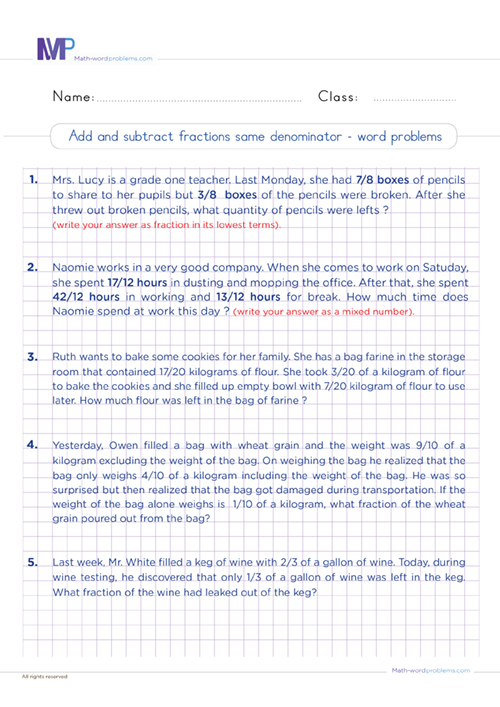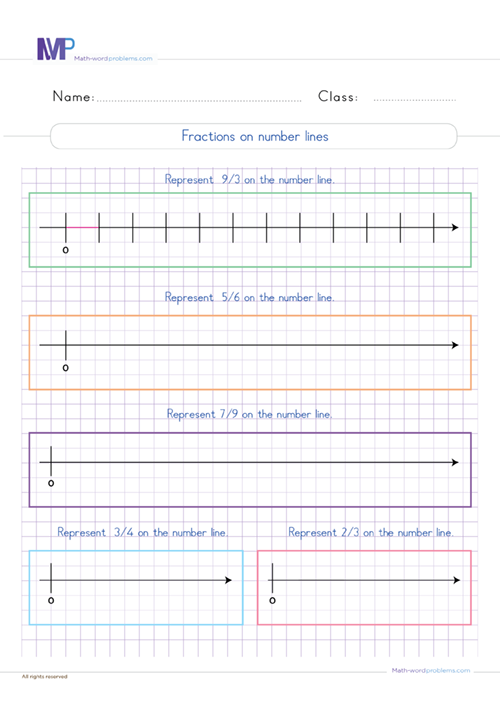 How to divide fractions and mixed numbers word problems
How to divide fractions and mixed numbers word problems

- INTRODUCTION
- Step 1 IDENTIFY
- Step 2 STRATEGIZE
- Step 3 SET UP
- Step 4 PROVIDE A SOLUTION
- Step 5 CHECK YOUR WORK
Get more contents on this skill...
Frequently, we ponder how to divide fractions and mixed numbers word problems. Worry not because by the time kids go through this fantastic fun designed step-by-step guide below, you’ll be amazed at how easily they will tackle any word problem they encounter.
In line with using these fun-designed step-by-step guides and solving techniques for kids, your kids will gain incredible skills and become experts in tackling word problems on dividing fractions and mixed numbers.
Steps to Solve Division of Fractions and Mixed Numbers Word Problems
Whether a tutor, parent, or learner, you’ll enjoy using these captivating steps to solve division of fractions and mixed numbers word problems. Since many kids often struggle with the concept of dividing fractions and mixed numbers word problems, we have considered this major challenge while designing these unique steps below.
Besides, this fantastic resource will eliminate all the distress sixth graders face whenever they want to know how to divide fractions and mixed numbers word problems. That is why we have designed thrilling real-life examples to thrill your learners and enable them to see how fantastic these steps work.
Step 1: IDENTIFY:
Let’s try to figure out the essential fractions and keywords in the word problem after reading the problem between the lines. Then, use these keywords to identify whether the problem involves division or any other operation.
- For instance, in dividing fractions and mixed numbers, we look for common keywords such as “go into,” “equally,” “get out of,” “out of,” “divide,” “each,” etc.
- ***One key Element for learners to understand is that they should not always rely on keywords alone. That is to say; the same keyword can have different meanings in different word problems.
- For this reason, we reiterate on the importance of reading the question very carefully to understand the situation that the word problem is describing, then figure out exactly which operation to use***
Step 2: STRATEGIZE:
How will you solve or tackle the word problem?
- As we mentioned above, from the keyword(s) in the word problem, you will know if you need to divide or perform any other operation.
- However, it would be best not to count only on keywords. Rather, try to understand the situation that the problem is describing.
- Having this in mind, construct short expressions/sentences to represent the given word problem.
Step 3: SET UP:
Now, all you need to do is write down a numerical expression representing the information given in the word problem.
Step 4: PROVIDE A SOLUTION:
From Step 3 above:
- First, if the word problem involves a whole number, then you will need to convert the whole number into a fraction by dividing the whole number by 1.
- Next, if the word problem involves a mixed number, then you will need to convert the mixed number into an improper fraction.
- Thirdly, the easiest way to divide fractions is to invert the second fraction and then rewrite the division problem as a multiplication problem.
- Fourthly, multiply the numerators across and also multiply the denominators across. Note that when multiplying fractions, a common denominator is not needed.
- Most importantly, simplify the fraction if possible.
- Lastly, always add the unit of measurement to your final answer if any.
Step 5: CHECK YOUR WORK:
Finally, ask yourself this question. Does my answer make sense? If YES, you are done. If NO, go back to step 1 and start all over again.
Examples on how to do addition, subtraction, multiplication, and division of whole numbers word problems
Example one: Here is how to add whole numbers word problems.
Step 1: As we move on after reading the question, the important numbers here are $125, $785, and $8,254. Also, the keyword(s) found in the word problem is “spend in all.”
Step 2: Now, how will you solve the problem? From the situation that the problem is describing and the keyword(s) “spend in all” found in the word problem calls for you to perform an addition operation.
As illustrated below, construct short expressions/sentences to represent the given word problem.
- Amount of money she spent on the dress = $125
- Amount of money she spent on the designer handbag = $785
- Amount of money she spent on the pair of designer shoes = $8,254
- Therefore, the amount of money she spent in all = the amount of money she spent on the dress + the amount of money spent on the designer handbag + the amount of money she spent on the pair of designer shoes
Step 3: Now, write down a numerical expression to represent the bolded sentence in step 2 above:
$125 + $785 + $8,254 = ?
Step 4: Form step 3 above, arrange or stack the values so their place values line up (i.e., the column method). Then, go ahead and add the values.
So, she spent $9,164 in all.
Step 5: Finally, check out your work to know if your answer makes sense, i.e., by estimating the numbers and calculating mentally. If the estimated answer is so close to the one you have, then your answer is correct but if the answer is not close to your answer, you’ll have to go back to step 1.
Example two: How to subtract whole numbers word problems.
Step 1: From th word problem, the important numbers are $451,254,900 and $26,600,582. Furthermore, the keyword(s) found in the word problem is “how much more.”
Step 2:Next, how will you solve the problem? You see that the scenario that the word problem presents and the keyword(s) “how much more” calls for you to use a subtraction operation.
Now, after knowing which operation you will perform, construct short expressions/sentences to represent the given word problem, as shown below.
- Amount of money Rita has in her trust fund = $26,600,582.
- Amount of money Charles has in his trust fund = $451,254,900.
- Therefore, the amount of more money Charles has in his trust fund than Rita = the amount of money Charles has in his trust fund – the amount of money Rita has in her trust fund.
Step 3: Now, you have to write down a numerical expression to represent the bolded sentence in step 2 above:
$451,254,900 – $26, 600,582 = ?
Step 4: From step 3 above, arrange or stack the values so that their place values should line up (i.e., use the column method of subtraction). Then, go ahead and subtract the values. Always remember to add the unit of measurement to your final answer if any.
So, Charles has $424,654,318 more in his trust fun than Rita.
Step 5: Finally, check out your work i.e. if the answer makes sense by estimating the numbers and doing mental calculation. If the answer is so close to the one you have, then your answer is correct but if the answer is not close to your answer, then go back to step 1.
Example three: How to solve division of whole numbers word problems.
Step 1: Right now, the important numbers here are 50,289,785 and 455 after carefully reading the word problem in-between the lines. As you continue reading the word problem, the keyword(s) found in the word problem are “each”, and “how many”.
Step 2:Now, how will you solve the problem? As you can see, from the situation that the word problem is describing and the keyword(s) found in the word problem calls for you to carry out a division operation.
Next, after knowing which operation you are going to perform, Construct short expressions/sentences to represent the given word problem.
- Number of books to be placed on shelves = 50,289,785
- Number of books each shelf can hold = 455
- Therefore, number of shelves in the library = Number of books to be placed on shelves ÷ Number of books each shelf can hold.
Step 3: Now, you have to write down a numerical expression to represent the bolded sentence in step 2 above:
50,289,785 ÷ 455 = ?
Step 4: From step 3 above, Set up a long division sign, arrange the numbers on it and then solve (follow the long division steps). Not forgetting to add the unit of measurement to your final answer if any.
So, there are 110,527 shelves in the library.
Step 5: Finally, check out your work i.e. if the answer makes sense by estimating the numbers and doing mental calculation. If the answer is so close to the one you have, then your answer is correct but if the answer is not close to your answer, then go back to step 1.
Example four: Here is an example of how to multiply whole numbers word problems.
Step 1: First, read the problem well and try to figure out the important numbers which are 89,785 and 125. Also, the keyword(s) found in the word problem is “how many” and “each”.
Step 2: Next, how will you solve the problem? The keyword(s) found in the word problem calls for you to perform a multiplication operation.
Now, after knowing which operation you are going to perform, Construct short expressions/sentences to represent the given word problem.
- Number of bags of apples Victoria harvested = 89,785 bags
- Number of apples in each bag = 125
- Therefore, number of apples she harvested = Number of bags of apples Victoria harvested × Number of apples in each bag.
Step 3: Now, you have to write down a numerical expression to represent the bolded sentence in step 2 above:
89,785 × 125 = ?
Step 4: From step 3 above, multiply the numbers using regrouping or any other multiplication methods like long multiplication, grid multiplication, and lattice method to determine the result. Always remember to add the unit of measurement to the final result if any.
Using the long multiplication method, we have
So, she harvested 11,223,125 apples
Step 5: Finally, check out your work to know if your answer makes sense, i.e., by estimating the numbers and calculating mentally. If the estimated answer is so close to the one you have, then your answer is correct, but if the answer is not close to your answer, you’ll have to go back to step 1.




